Subscribe now to get notified about IU Jharkhand journal updates!
Influence of professional development in succession planning and retention
Abstract :
Transforming leaders with a great vision about their followers generally creates history in the field of subordinate retention. A research conducted on employee retention stated that perception of managers regarding the level of retention of employees if he thinks about the followers with equity this will motivate subordinates to do well for the organization and on the same time felt good for them as well. A study conducted on retention of employees explored that leadership styles has a great impact on level of retention because it directly affects the cognitive state of employees. Job satisfaction will increase your employee retention rate. Once put in the time, effort and investment to hire the best employees possible need to retain that talent. A competitive payout, benefits are not only a factor but they are not only reasons enough to keep them in an organization. The professional development (PD) results in knowledge creation, which helps in differentiating organizations and employees who are successful from those who are not. It helps in improving performance, productivity, satisfaction, etc. Employees always wanted further growth within the organization via job rotation if the organization develops a successful professional development (PD) planning structure for career opportunity. While employee grow in their positions thru professional development (PD), companies benefit thru employees’ loyalty, commitment to the job, belongingness and shared feeling of development along with organization. The employee’s commitments will improve and it is an important element in human resource management practices especially in employees’ retention. Actively pursuing professional development (PD) ensures that knowledge and skills stay relevant and up to date. It also allows employees to be more aware of changing trends and directions in an industry.
Keywords :
Professional Development, Commitment, Succession Planning, Training, Up-skilling, Productivity, Performance1. Introduction
A study on employee retention and engagement stated that good Leaders plays very key role in the success of an organization because their quality motivated and induce the sub-ordinate to do well and retain for longer periods of time. For example, Leaders and subordinates are so much correlated with each other to discuss their level of engagement.
A study stated that those leaders who support the behavior of subordinated in task delegation and performing the activities will lead to positive engagement with them. Transforming leaders with a great vision about their followers generally creates history in the field of subordinate retention. The present pilot study focuses on analysis of factors impacting the influence of professional development in succession planning and retaining talents in the healthcare sector - special reference to hospitals in different Emirates in UAE.
Renowned article, “Strategies for survival in the war of talent” concluded that employee leaves the job because the boss is not supportive. .According to Hatch and Dyer (2004); Bierman, Shimizu and Kochhar (2001) leveraging human capital is one promising area where needs to concentrate and improve.
1.2 DEFINITION:
The roles of the HR practitioner are expanding. Besides just strategically dealing with leveraging human capital and delivering administrative services on a day to day basis, HR functions are expected to do a lot more. HR practitioners are now looked upon as strategic business partners and considered leaders of change.
As a consequence of a volley of criticism and questions on the validity of HR functions in the last decade, a significant amount of research on HR functions are followed. It eventually magnified the scope of HR which is now reflected as the effect of their practices in organization performance. The competitive industry and demanding market pushed HR practitioners to go beyond their boundary and restructure themselves to expand their functional areas.
Review of Literature
Training is a systematic approach of learning and development that improve the individual, group, and the organization (Goldstein and Ford, 2002). It has an integrated aim of developing employees and guiding them in fulfilling the organizational needs besides enhancing employees potential to create career development opportunities (Pont, 2003). Secondly, Chen et al. (2007), training programs should concentrate on achieving “organizational strategic goals”. It is essential to tailor training programs to meet organization’s goals, as ineffective training programs degrade organizational performance (Chen and Klimoski, 2007). Training acts as intervention to improve the organization’s goods and services quality in tough competition by upgrading in technical skills of employees (Manju and Suresh 2011). There are few other strategies can be considered to retain a talent which can be considered as non-training measures.
Various studies have been done in the area of employee retention and engagement. A research conducted on employee retention stated that perception of managers regarding the level of retention of employees if he thinks about the followers with equity this will motivate subordinates to do well for the organization and on the same time felt good for them as well. A study conducted on retention of employees explored that leadership styles has a great impact on level of retention because it directly affects the cognitive state of employees. A five step model is suggested for retaining the talents:
- Problem Recognition: The organization recognizes a problem in losing the best talents. An awareness of professional development and recognition activities are important at this stage
- Gather available information: An analysis is required to understand the need of professional development, rewards, engagement, recognition, support opportunity talents, fair compensation and benefits, etc.
- Tackling Opportunity gap: Creating an inclusive talent workforce pipeline is fit so everyone has access to opportunity.
- Value to business: Ensuring entry-level and frontline employees have a sense of ownership and purpose in their work
- Post-professional development: A bottom-line benefits to business of evolving their recruiting, hiring, improved retention, stronger engagement, diversity of thought and satisfaction rate
A common thing observed that people feel like they’ve already learned everything they can in their current role, they’ve reached their capacity and they’re hungry for more enrichment. After a couple of years in a position, people start thinking, ‘What’s next?’ Funds spent on recruiting and hiring, onboarding, lost productivity and lost engagement due to the overall impact on employee morale can add up. If we want to attract and retain people, we must provide a clear path to how someone is going to advance in their career. That conversation starts with; how we as an organization are going to develop that individual.
According to the EdAssist study, 72 percent of survey respondents do not believe their schooling effectively prepared them for the workplace. This doesn’t have to be the case.
“Professional development (PD) opportunities provide today’s employees with an opportunity to maintain and obtain the skills required for their current jobs – as well as steps up in their career path,” Salzman points out. “Employees who do not see a clear path are at risk of leaving”. General studies indicate that just one-third of employees are satisfied with their organization’s commitment to professional development. In fact, 21 percent cite a lack of professional development(PD) opportunities as a reason to leave their current position. This anecdotal evidence is hardly a fluke. A recent survey of more than 2,000 employees reveals organizations that offer professional development (PD) opportunities have employees who are 15 percent more engaged in their work. Such businesses also see 34 percent higher retention rates than those that don’t offer similar opportunities.
Organizations are forced to operate within an environment having structural change and competition. These factors forced the organizations to give more attention to their employees, working on keeping them satisfied and engaged. The shortfall of qualified and talented employees put additional pressure on the organizations to work effectively on retaining their employees. Therefore attracting, satisfying and retaining qualified and talented employees become future survival, performance and profitability. It also identified parameters that can help to retain high-quality staff are hiring staff that have passion, respect, and concrete skills for working, aligning staff skills with tasks, making training substantive and accessible, offering staff development and monitoring program quality. Among these, professional development (PD) is important for retaining qualified staff because it provides opportunities for growth and can improve worker satisfaction. Furthermore, professional development (PD) increases staff efficacy and feelings of competency, thereby bolstering motivation and a sense of belonging in the program.
The human resource department is committed to bring out the best in employees. It aims not only to look into the overall productivity and profitability of the organization but also aims at individual growth. It does so by implementing human resource practices like mentoring, talent spotting and support network.
A conceptual framework was built based on the Guest Model of HRM (1997) as a guide for this study. This model has been used to analyze the human resource professional development (PD) and employees’ retention as well. Its practices can be used to predict the level of employees’ retention. Based on this, professional development (PD) practice is could be a variable in the study of its relationship with employees’ retention.
increasingly important. In fact, organizations’ ability to satisfy and retain their qualified employees is crucial for

Figure1: The conceptual framework adopted from the Guest Model of HRM (1997)
Employees always wanted further growth within the organization via job rotation if the organization develops a successful professional development (PD) planning structure for career opportunity. Moreover, the employee’s commitments also will improve the structured talent management which classified as a part of the important element in human resource management practices especially in employees’ retention (Baruch &Peiperl, 2000). Thus, self-evaluation development will increase the employee performance in the organization and improve the skills in work environment would increase the employees’ retention (Baruch &Peiperl, 2000).
Job satisfaction will increase your employee retention rate. Once put in the time, effort and investment to hire the best employees possible need to retain that talent. A competitive payout, benefits are not only a factor but they are not only reasons enough to keep them in an organization; to employ them for the long haul.The PD results in knowledge creation, which helps in differentiating organizations and employees who are successful from those who are not. It helps in improving performance, productivity, satisfaction, etc. Employees always wanted further growth within the organization via job rotation if the organization develops a successful PD planning structure for career opportunity. While employee grow in their positions thru PD, companies benefit thru employees’ loyalty, commitment to the job, belongingness and shared feeling of development along with organization.The employee’s commitments will improve and it is an important element in human resource management practices especially in employees’ retention.Actively pursuing PD ensures that knowledge and skills stay relevant and up to date. It also allows employees to be more aware of changing trends and directions in an industry.
- Create an environment that makes your employees feel like an asset to your company: Allow them to feel secure in their job. Get their input about rules or changes that may need to be made.
- Make expectations and goals of the company clear: Be sure you have job descriptions so your employees know what is required of them. If there are changes that need to be made, don’t expect them to learn that by osmosis. You must communicate directly and clearly. Good employees want to please you, but they need to know what it is they need to do to make that happen.
- Create an open and honest work environment: Give feedback on work performed and be willing to listen, really listen, to the concerns of your employees. Accept suggestions for problem-solving. Be available and open when your employee asks for your guidance.
- Provide opportunities to grow and learn, and let your employees know there is room for advancement in your company: Provide tuition for continuing education classes. Give challenging and stimulating work. Tap into their passion and allow them to focus their time and energy on projects they can enjoy. Let them know what career development plans you may have for them and what opportunities are available for them to grow with the company.
- Recognize and reward good work: Monetary bonuses are always nice, but recognition of a job well done goes a long way to creating good will and loyalty. In order to retain talent, you must make them feel appreciated, respected and worthwhile. Recent studies show that when talented employees feel undervalued and unappreciated, they look for other employment. They need to feel that their contributions to the business are important.
2.1 RELEVANCE OF THE TOPIC:
According to LinkedIn’s 2018 Workforce Learning Report, a whopping 93% of employees would stay at a company longer if it invested in their careers.The objective of the study is to assess importance of professional development (PD), succession planning and retaining talented staffs. It signals that the employer values their people and is actively interested in their success — not just on the job, but over the long haul. It will help improving loyalty and staff retention.
It’s clear that employee retention and recruiting are topics of intense focus for organizations across the nation. As data supports the importance of professional development (PD) opportunities, it may be time for healthcare business to consider ways to cultivate paths for employees to grow.
The bottom line is that any organization that doesn’t provide professional development (PD) incentives to their people is not optimizing its human capital.
Professional development (PD) can help healthcare professionals improve both their technical and people skills, both of which are essential for providing an exceptional patient experience, improving productivity, and increasing employee satisfaction. The suggestions are:
- Demonstrate a clear growth path: According to the Leaders for Today survey, the lowest-ranked parameter for workplace satisfaction is having the opportunity for professional development (PD). Having an employee development plan will help keep valuable staff engaged with your organization because they know there will be opportunities for growth in their future. Nevertheless, there is an increasing awareness that employee engagement is pivotal to successful commercial and business performance, where engaged employees are the ‘backbone of good working environments where people are industrious, ethical and accountable’ (Levinson, 2007a; Cleland et al, 2008).
- Provide Opportunities: Having a skill set program in place ensures that employees are being given the tools to help them achieve their career goals, improve the patient experience, and support the organization as a whole.
Healthcare employee retention in UAE healthcare sector is a significant challenge to the industry, and employee turnover is not good for anyone involved. It is expensive for organizations, worrying for employees who want a stable work environment, and does not create a positive environment for patients. Addressing some of the largest gaps with above recommended strategies can help hospital or healthcare organization reduce employee turnover and attract new, qualified candidates, because existing employees, current and potential, will feel valued and excited about being part of the organization. It’s also important to include all employees in these opportunities encourage everyone in the organization equally to seek improvement opportunities and ensure they know, they have a support.
Employee retention is one of the biggest threats to healthcare businesses throughout the country. The tide has shifted in recent years, and the employees now have more power than ever in their relationships with employers. In fact, 65 percent of workers believe they can leverage this control to their advantage through salary and benefit negotiations. By taking a proactive approach to your employee growth and professional development strategies, you can mitigate employee turnover and drive more productivity.
Methodology
3.1 SCOPE AND COVERAGE OF RESEARCH STUDY
The scope of the research would be covering the influence of professional development (PD) in employees’ productivity, succession planningand retention in the overall business.
3.2 OBJECTIVES OF RESEARCH STUDY
The objectives of the study are:
- To find out the why the professional development is important
- To identify the training helps to boost employee confidence
- To find out the importance of professional development in career growth
- To identify the influence of professional development interventions on productivity
- To suggest the techniques to overcome the redundancy and foster training programs
3.3 RESEARCH METHODOLOGY & DETAILS OF TOOLS
Discuss the research design, research problems, important of the study, scope and significance of the study, source of data, statistically techniques used and objective of the study and limitations of the study.
3.4 RESEARCH DESIGN AND RELIABILITY
A research design is an arrangement of conditions for collection and analysis of data in a manner that aims to combine relevance to the research. The purpose of the study is providing an observation and importance of Professional development improves productivity, succession planning and retention are critical for company's success.
3.5 NATURE & SOURCE OF DATA COLLECTION:
The relevant data has been collected from the primary sources and secondary sources. The primary data is collected by a questionnaire from the employees. For this purpose of data collection, the questionnaire was circulated among the employees to collect information. The secondary data is collected by newspaper company journals, magazines websites etc.
3.6 DATA SAMPLING
- Universe of the Study:Those employees who are working in various departments like customer service, insurance, business development, finance, accounts, marketing, quality, infection control, medical records, stores, purchase, information technology, nurses and paramedics working in different hospitals in the Emirates of UAE.
- Sampling method:Convenient random sampling. A sample of 62 respondents was taken using random sampling. The researcher contacted and brief summary of the nature of the study and details in the questionnaire were narrated to them.
- Proposed sample size:As per the respective calculation methods, time and cost constrain
3.7 QUESTIONNAIRE ADMINISTRATION:
The researcher prepared a set of questionnaire. A four point scale “Strongly Agree” to “Strongly disagree" was used for this purpose.
3.8 PERIOD OF STUDY:
The present study had been undertaken for a period of 12 weeks, in which it had divided into three stages as such. Stage I is of research problem and collection the literature of the topic chosen. Stage II is of analysis and interpretations by using different statistical tools, findings and recommendations.
3.9 STATISTICAL TOOLS USED:
- For the purpose of present study percentage analysis was used.
4.0 LIMITATIONS OF STUDY:
- The sample size chosen is covered among staffs working in the healthcare sectors located in different hospitals in the Emirates of UAE.
- The sample size of study is low, so it cannot be generalized therefore study could be generalized by increasing the sample size to have a wider focus.
- The results can be tested by adding new variables to the model for example feedback, mentoring, on the job training etc.
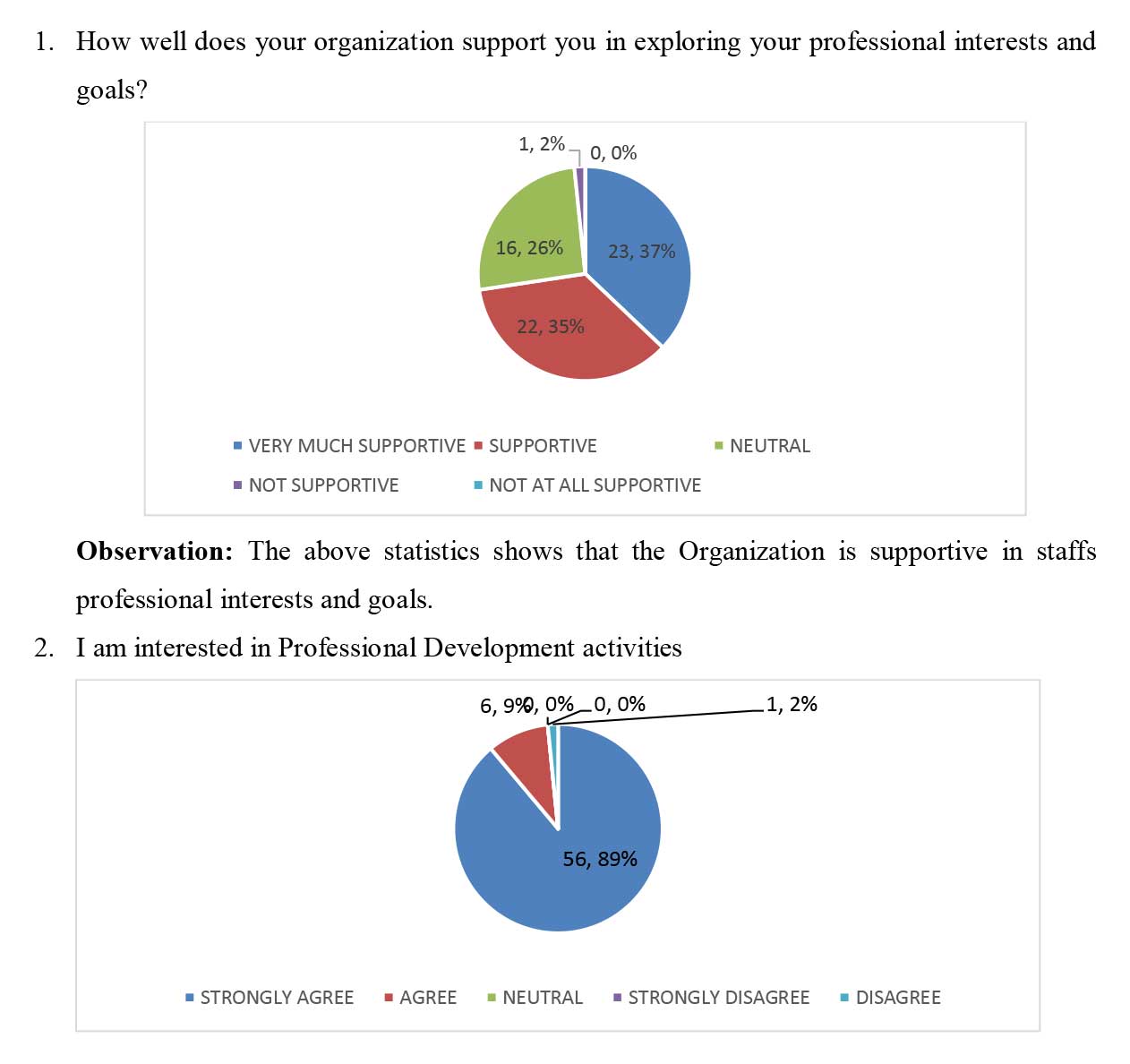
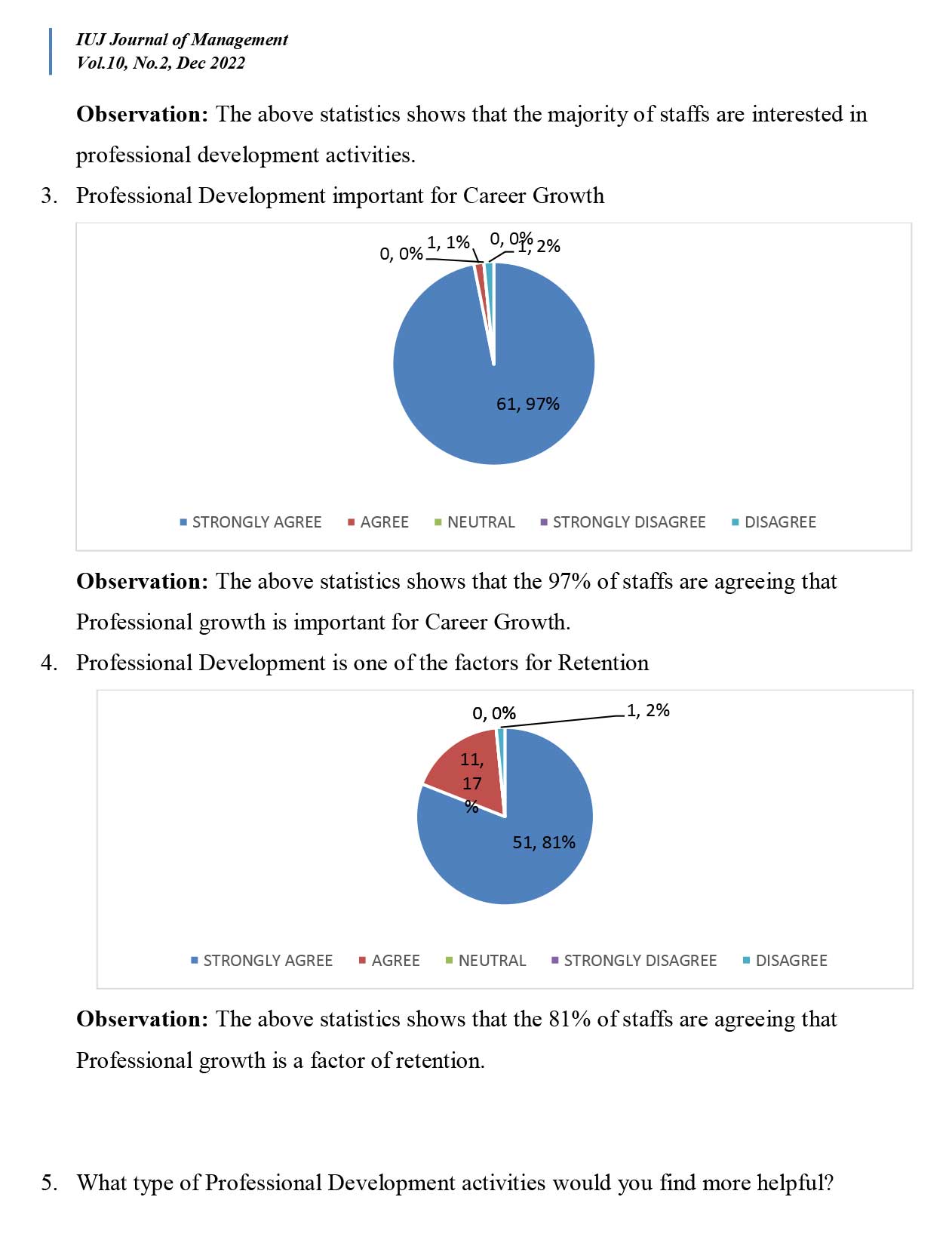
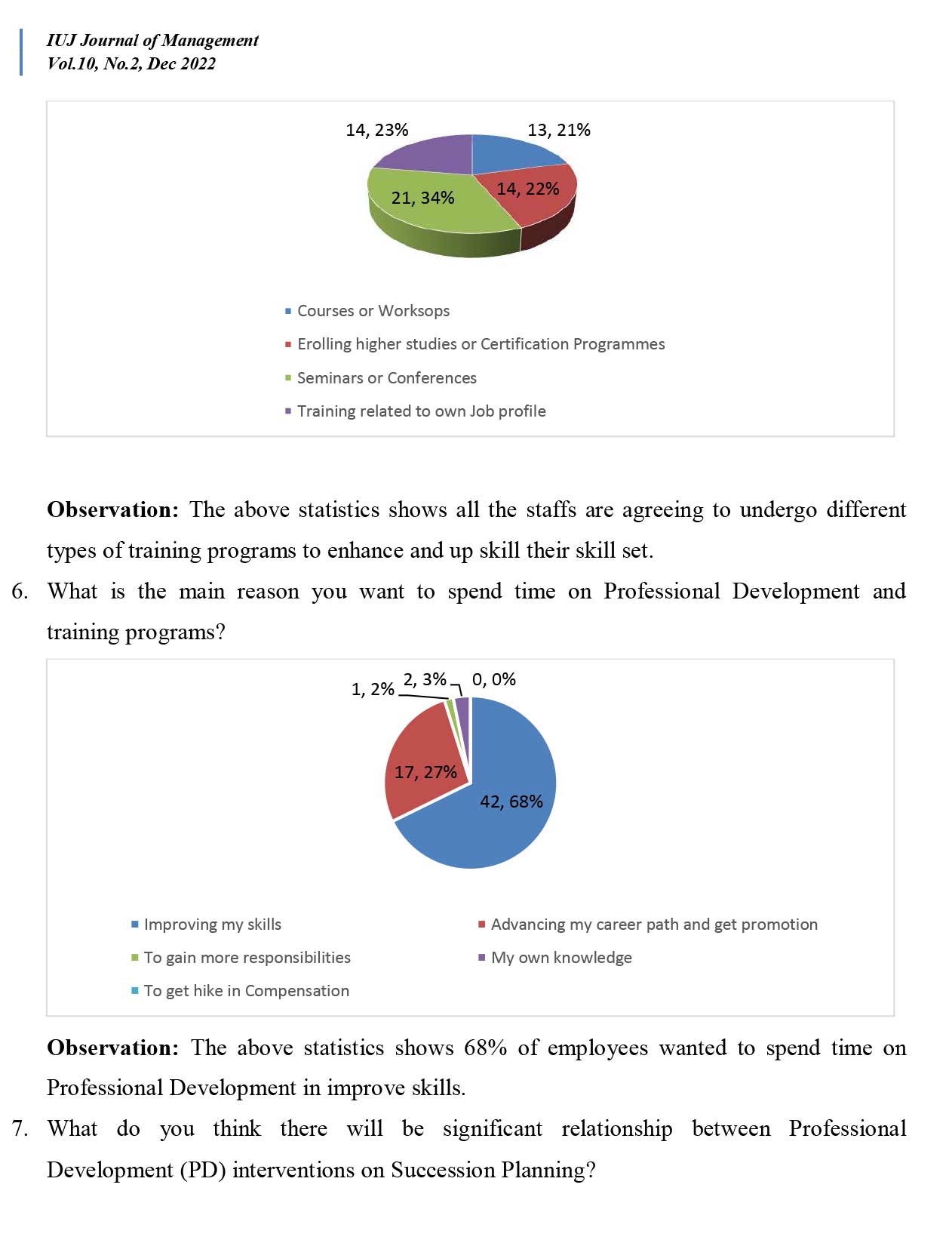


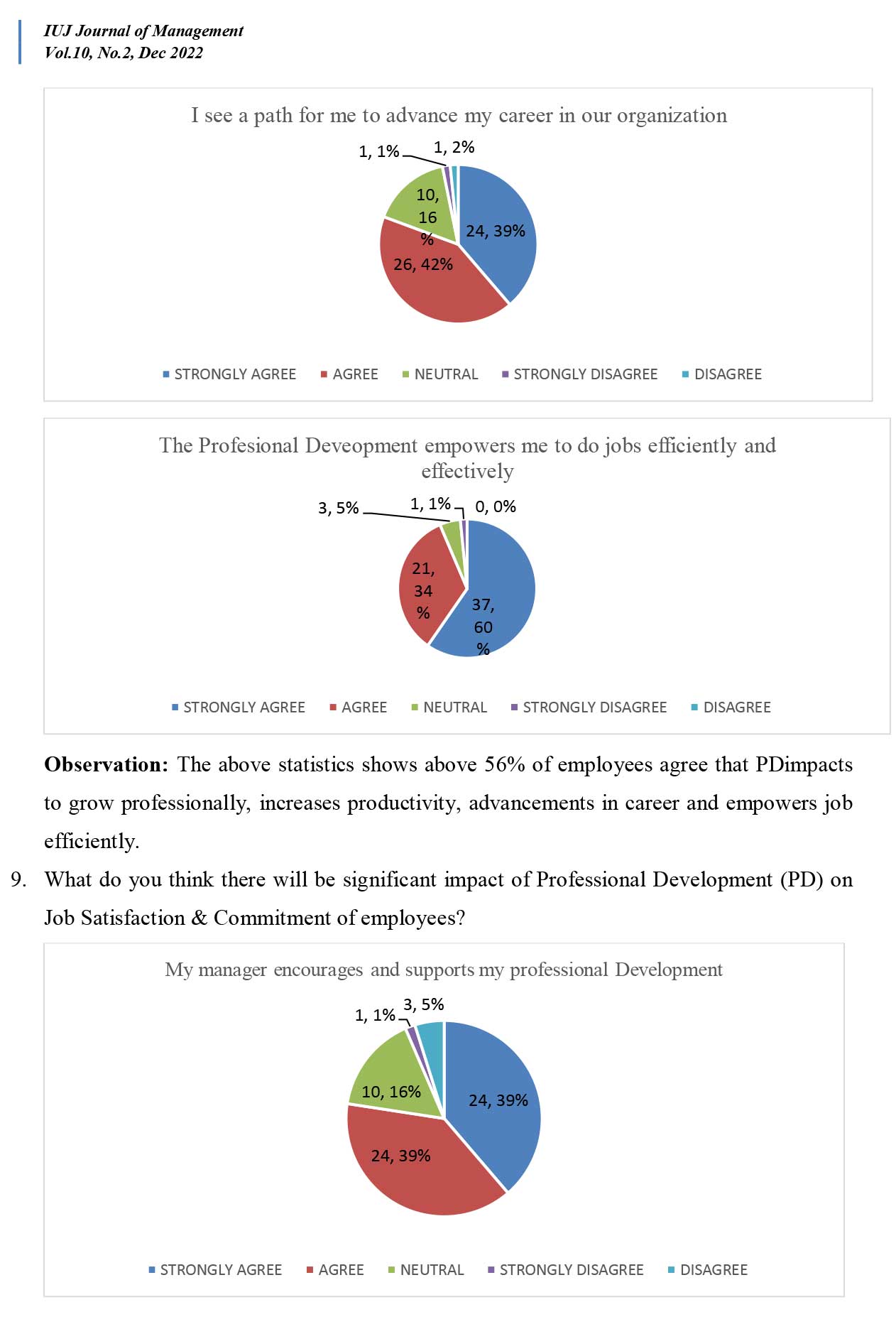
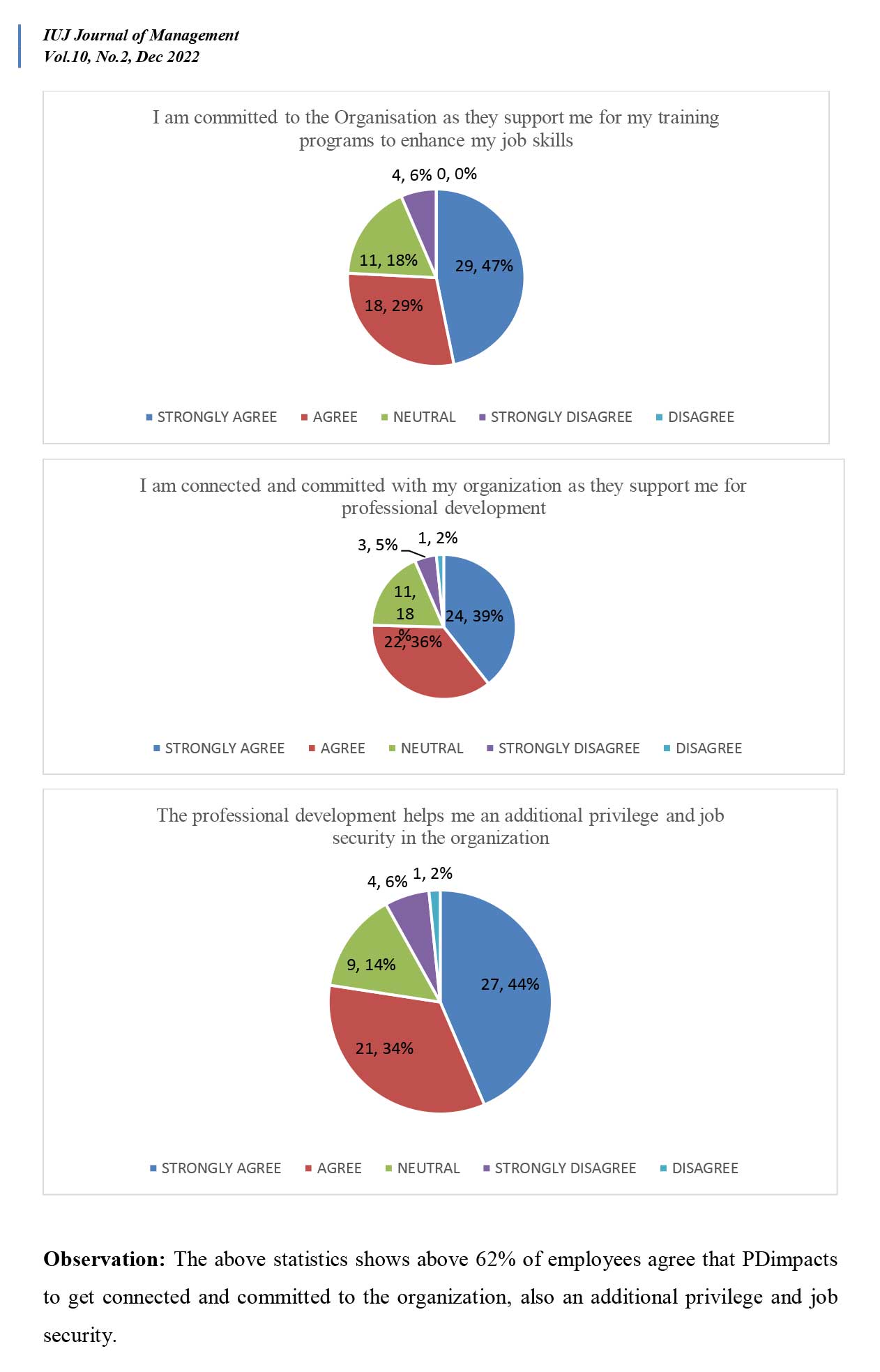
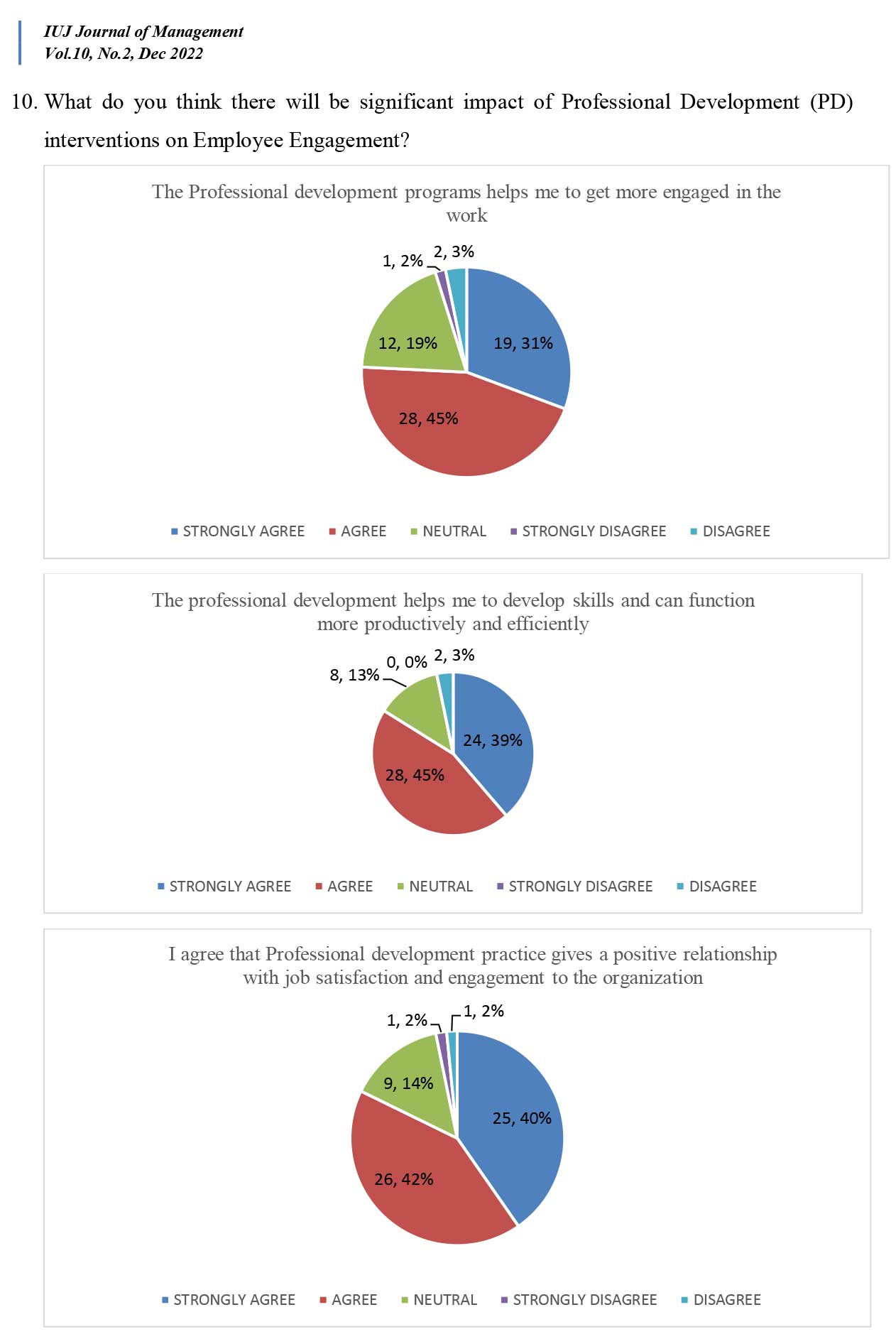

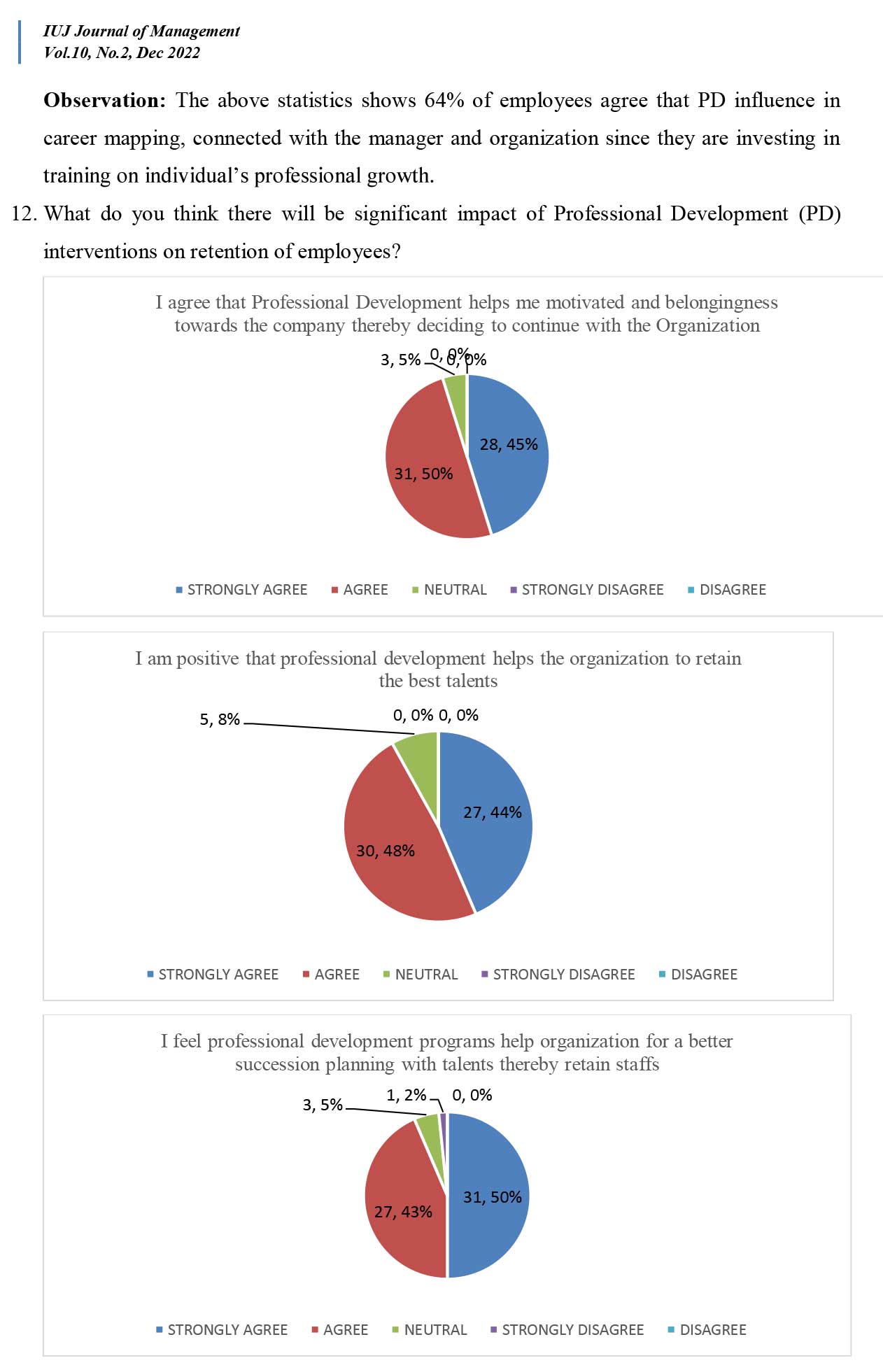
Observation: The above statistics shows majority of employees agree that PDinterventions helps motivated and belongingness towards the company and retain talented staffs thru succession plans.
6.1 FINDINGS AND SUGGESTIONS
The finding of the present revealed the following
- Most of the respondent agrees that professional development influence career progression and up skilling.
- There is significance relationship between professional development and succession planning thereby retention of talented staffs.
- The dimensions of individual’s aspiration in career progression, cross function job trainings and motivation by the managers have contributed to commitment and connectivity to the organization.
- The employee feels that an organization investing in training and education has a greater impact and acceptance.
- The employee agrees that professional development increases their productivity and empowers to perform job effectively.
6.3 CONCLUSION
The findings in this study indicate that there is a positive and significant effect of training on performance, job satisfaction, career progression, and contribution to the job. It is to mediate the relationship between professional development on productivity and retention on talents by succession plan. The reliability shown in the instruments used in this study can be used as a basis for further research and can be used as an empirical consideration for further research development in various industries. Healthcare leaders identified training and development is the key findings to retain top talent which influence career progression. To improve employee performance in order to achieve better company productivity, namely the way employees can see opportunities, benefits, working conditions and enhancement. Leaders could consider investing generously in career development, capability development as a practical employee retention strategy.
